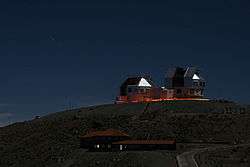Magellan Telescopes
 | |
| Organisation | Carnegie Institution for Science |
|---|---|
| Location(s) | Las Campanas Observatory, Chile |
| Coordinates | 29°00′54″S 70°41′30″W / 29.015°S 70.6917°WCoordinates: 29°00′54″S 70°41′30″W / 29.015°S 70.6917°W |
| Altitude | 2,516 m (8,255 ft) |
| Wavelength | Optical, near-IR |
| Built | First lights September 15, 2000 and September 7, 2002 |
| Diameter | Both 6.5 m |

The Magellan Telescopes are a pair of 6.5 m (21.3 ft) diameter optical telescopes located at Las Campanas Observatory in Chile. The two telescopes are named after the astronomer Walter Baade and the philanthropist Landon T. Clay.
First light for the telescopes was on September 15, 2000 for the Baade, and September 7, 2002 for the Clay.
A collaboration between Carnegie Institution for Science, University of Arizona, Harvard University, The University of Michigan and the Massachusetts Institute of Technology built and operate the twin telescopes.
It was named after the sixteenth-century Portuguese explorer Ferdinand Magellan.
Magellan Planet Search Program
Is a survey of start searching for planets using the MIKE echelle spectrograph mounted on the 6.5m Magellan II (Clay) telescope.[1][2]
MagAO Adaptive Optics System
In 2013, Clay (Magellan II) was equipped with an adaptive secondary mirror called MagAO which allowed it to take the sharpest visible-light images to date, capable of resolving objects 0.02 arcseconds across -- equivalent to a dime (1.8 cm) seen from 100 miles (161 km) away.[3]
MagAO was originally intended for the Large Binocular Telescope (LBT), but the secondary mirror was damaged before it could be installed. The project leader Laird Close and his team were able to repair and repurpose the broken mirror for use on Magellan II. As built for the LBT, the original MagAO mirror had an diameter of 36 inches (910 mm). However, the edge of the mirror was broken. Technicians at Steward Observatory were able to cut the mirror to 33.5 inches (850 mm) in diameter, thereby removing the broken edge.[4]
Photos
 Part of Las Campanas Observatory after snowfall, with the Magellan telescopes at the right.
Part of Las Campanas Observatory after snowfall, with the Magellan telescopes at the right. Telescopes at night
Telescopes at night
See also
References
- ↑ Low Mass Companions for Five Solar-Type Stars from the Magellan Planet Search Program, Dante Minniti et.al, 2008.
- ↑ Five Long-period Extrasolar Planets in Eccentric orbits from the Magellan Planet Search Program, Pamela Arriagada, et.al, 2010.
- ↑ New Telescope Tech Takes Sharpest Night Sky Photos Ever, Mike Wall, 2013.
- ↑ University of Arizona astronomers see more clearly than ever, Tom Beal, 2013.
External links
- Magellan Project homepage – Carnegie Institution for Science
- Las Campanas Observatory Magellan Telescopes homepage